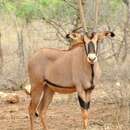en
names in breadcrumbs


The East African oryxes have traditionally been treated as a single species, Oryx beisa (and often even considered conspecific with the Gemsbok, O. gazella, of southwestern Africa).According to Groves (2011), however, although they are very similar in appearance they are best treated as three distinct species: Beisa Oryx (O. beisa), found in northern and central Somalia and the Ogaden region of Ethiopia north to Berbera, west to Eritrea, and south into the Awash Valley; Galla Oryx (O. gallarum), found in northern Kenya and northeastern Uganda and extending into Somalia and southeastern Ethiopia; and Fringe-eared Oryx (O. callotis), found in southeastern Kenya and northeastern Tanzania.
The Beisa Oryx is a large antelope with a thick neck, long face, and long straight horns. It is found mainly in desert country, arid grassland, and scrub. It typically occurs in small herds of 7 to 30 individuals.It is reported to be common in the Awash National Park, but declining elsewhere due to hunting and overgrazing. Population declines likely approached 25% over the past three generations.
(Kingdon 1997; Groves 2011)
The East African oryx (Oryx beisa), also known as the beisa,[4] is a species of medium-sized antelope from East Africa. It has two subspecies: the common beisa oryx (Oryx beisa beisa) found in steppe and semidesert throughout the Horn of Africa and north of the Tana River, and the fringe-eared oryx (Oryx beisa callotis) south of the Tana River in southern Kenya and parts of Tanzania. The species is listed as Endangered by the IUCN.
In the past, some taxonomists considered it a subspecies of the gemsbok (Oryx gazella), but they are genetically distinct; the diploid chromosome count is 56 for the beisa and 58 for the gemsbok.
The East African oryx stands just over a metre at the shoulder and weighs around 175 lb (79 kg). It has a grey coat with a white underside, separated from the grey by a stripe of black, with black stripes where the head attaches to the neck, along the nose, and from the eye to the mouth and on the forehead. The mane is small and chestnut-coloured; the ringed horns are thin and straight. They are found on both sexes and typically measure 75–80 cm (30–31 in). Comparably, the gemsbok has an entirely black tail, a black patch at the base of the tail, and more black on the legs (including a patch on the hindlegs) and lower flanks. The smaller Arabian oryx is overall whiter with largely dark legs.
East African oryx live in semidesert and steppes, where they eat grasses, leaves, fruit and buds. They are able to store water by raising their body temperatures (so as to avoid perspiration). They gather in herds of five to 40 animals, often with females moving at the front and a large male guarding from the rear. Some older males are solitary. Radio tracking studies show the solitary males are often accompanied for brief periods by breeding-condition females, so it is probable they are executing a strategy to maximise their chances of reproduction.
The East African oryx (Oryx beisa), also known as the beisa, is a species of medium-sized antelope from East Africa. It has two subspecies: the common beisa oryx (Oryx beisa beisa) found in steppe and semidesert throughout the Horn of Africa and north of the Tana River, and the fringe-eared oryx (Oryx beisa callotis) south of the Tana River in southern Kenya and parts of Tanzania. The species is listed as Endangered by the IUCN.
In the past, some taxonomists considered it a subspecies of the gemsbok (Oryx gazella), but they are genetically distinct; the diploid chromosome count is 56 for the beisa and 58 for the gemsbok.